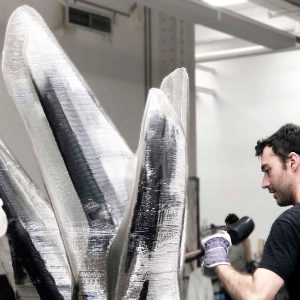CLOUD AFFECTS | WITH PHILIP SAMARTZIS & ROLAND SNOOKS
_
_
Cloud Affects, insitu, Shenzhen Biennale. Photo: RMIT University
Cloud Affects is a large-scale architectural installation by Associate Professor Roland Snooks, Chief Investigator, Design Robotics, and Associate Professor Philip Samartzis, sound artist. Crafted using algorithmic generative design and robot-assisted additive manufacturing, this work explores the impact of cloud computing. Often thought of as immaterial and benign, the cloud is, in fact, a vast ecosystem of over 40 billion devices, powered by a network of energy-hungry data centres, which will consume as much as twenty percent of the earth’s energy generation by 2025. This novel research outcome operated as an agent for meaningful public engagement, as well as an exemplar of the structural potential of 3D printed assemblages.
Robotic-assisted 3D Assemblage, Urban Art Projects, Brisbane
agentBody Algorithms & Topological Complexity
Snooks and Laura Harper, Roland Snooks Studio, explain in their paper, “Printed Assemblages: A Co-Evolution
of Composite Techtonics and Additive Manufacturing Techniques” (FABRICATE 2020), how Cloud Affect was
designed using an agentBody algorithm. This behavioural formation process combined form, structure
and ornament into topologically-complex lattices and surfaces. These architectural behaviours establish
local relationships between material elements. Such interaction is driven by direct criteria, like
structural or programmatic requirements, or more esoteric concerns relating to the generation of form or
pattern.
Snooks and Harper explain the evolution of this process:
“This methodology, which has been in development since 2002, draws on the logic of swarm intelligence
and operates through multi-agent algorithms (Snooks, 2020). Swarm intelligence describes the collective
behaviour of decentralised systems, in which the non-linear interaction of its constituent parts
self-organise to generate emergent behaviour (Bonabeau et al., 1999). Repositioning this logic as an
architectural design process involves encoding architectural design intention within computational agents.
It is the interaction of these agents that leads to a self-organisation of design intention and the
generation of emergent architectural forms and organisational patterns.” (2020, p.204).

Installing Cloud Affect. Photo: RMIT University
Advanced Manufacturing Cloud Affects
Snooks and his team manifested their emergent form
using carbon fibre and large-scale robot-assisted 3D-printing. Essentially, the internal lattice
became a structural skeleton, containing a series of hollow formworks, enclosed in a second translucent
skin. In addition, the inner and outer geometries were periodically laminated to ensure structural rigidity.
Each joint was resolved by casting laser-cut steel plates into the carbon fibre. Certainly, the use of this technology increased quality, reduced
risk, and resulted in more efficient workflows.
Cloud Affects demonstrates that structure is not subservient to the geometry of the skin (such as
taping to inflatable or printed surfaces) or the convergence to physically efficient forms (such as minimal
surfaces), but instead, structure and skin negotiate a nuanced interrelationship with the capacity to
generate complex and intricate form. Given the limitations of the printing bed, the final work was designed
a series of pre-fabricated components with the capacity to be disassembled. Snooks discusses this process in
detail in Inside the Learning Factory: Architectural Robotics.
The final outcome draws complex data design and manufacturing processes into focus, questioning how viewers
might feel about the most sophisticated technologies – software, AI, and algorithms – all powered by
polluting carbon-based systems that contribute to Climate change. In contrast, the 3D printing process
resulted in a form of digital craft akin to coiling in pottery or basketry, creating a tactile surface
capable of refracting light and drawing viewers to the piece. This juxtaposition between tangible and
intangible materials, technology and making, old and new processes, creates a powerful pause for
thought.

Cloud Affects Assembly in process. Photo: RMIT University
Design Robotics & Futuremaking
This project attempted to reify a structure from the nebulous via a process of futuremaking: to materialise
and express intangible algorithms and make real the energy required to prop up the virtual cloud. In
manifesting the tangible, it sought to offer a new architectural geometric expression, one that can only
emerge from the use of advanced computation within both the design and robotic fabrication processes.
Future cities will increasingly rely on advanced cloud computing, from simple algorithmic procedures to
artificial intelligence, for their design, construction and infrastructural logistics. These cloud-based
algorithms become the unseen structural framework behind the evolution of urbanism and architecture. Using
technology to assess impact and evolve material outcomes inevitably evokes conversations beyond the realms
of art, architecture and design.

This article is adapted from:
Samartzis, Philip “Cloud Affects” Bogong Sound, Bogong Centre for Sound, 30 March 2020,
http://bogongsound.com.au/projects/cloud-affects. Accessed 20 Oct. 2020.
Snooks, Roland, and Laura Harper. “Printed Assemblages: A Co-Evolution of Composite Techtonics and Additive
Manufacturing Techniques.” FABRICATE 2020: Making Resilient Architecture, by Jane Burry et al., UCL
Press, London, 2020, pp. 202–209. JSTOR, www.jstor.org/stable/j.ctv13xpsvw.31. Accessed 19 Oct.
2020.